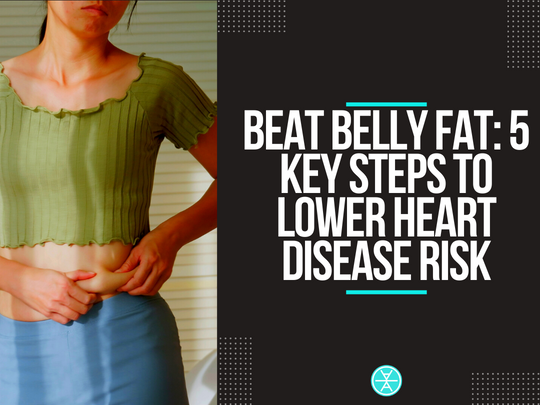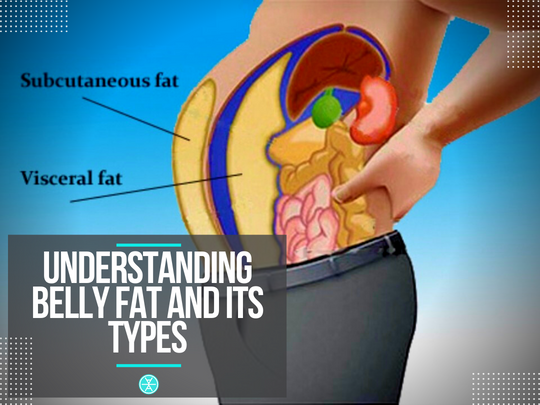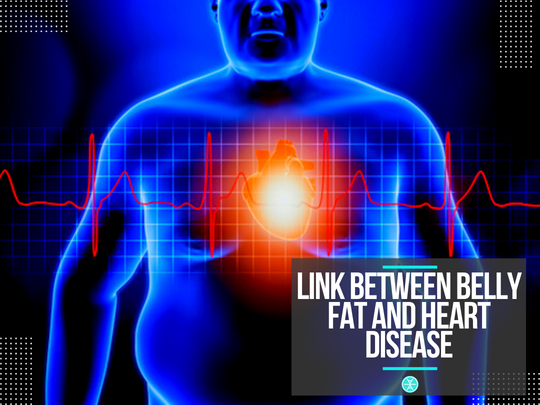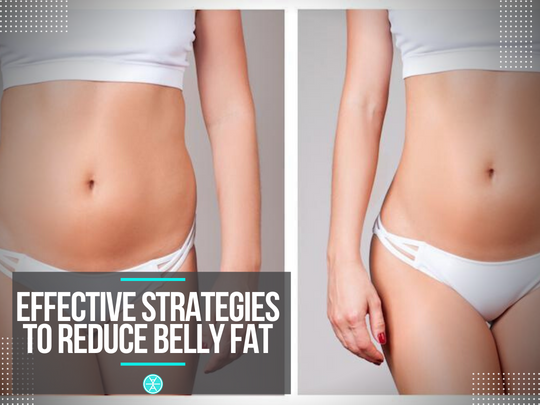
Table of Contents
Introduction
Welcome to ‘Beat Belly Fat: 5 Key Steps to Lower Heart Disease Risk.’ In this blog, we will shed light on an important health concern: the connection between belly fat and heart disease.
Belly fat goes beyond aesthetics; it serves as a significant indicator of your cardiovascular health. Specifically, the type of fat that accumulates around your abdominal organs, called visceral fat, silently increases the risk of heart disease.
Our goal is to unpack the complexities of how excess abdominal fat affects heart health and, most importantly, provide you with actionable steps to address it.
By understanding this connection, you can take proactive measures to protect your heart and improve your overall well-being.
Join us as we explore effective strategies to reduce belly fat and significantly decrease the risk of heart disease. This knowledge and these tools will empower you to lead a healthier life.
Begin your journey towards a healthier, slimmer you by understating the crucial connection between belly fat and heart disease.
Belly fat, especially visceral fat, goes beyond affecting your appearance; it actively contributes to the risk factors for heart disease, such as inflammation, high cholesterol, and insulin resistance.
This type of fat releases harmful substances that can negatively impact your cardiovascular health. By understanding this link, you empower yourself with the knowledge to make informed decisions about your health.
Taking proactive steps to reduce belly fat leads to more than just a slimmer waistline; it strengthens and improves the health of your heart. It’s about turning lifestyle choices into life-saving actions.
Remember, each step you take to reduce belly fat is a step towards reducing your risk of heart disease and paving the way for a vibrant and healthier life.
Understanding Belly Fat and Its Types

Belly fat and the difference between subcutaneous and visceral fat
When it comes to belly fat and its effect on our well-being, it’s important to differentiate between two types: subcutaneous and visceral fat.
Subcutaneous fat is the fat just beneath the skin, the kind you can pinch. While it may be a cosmetic concern for some, it is generally not as harmful as its counterpart.
Visceral fat, however, is a different story. It is stored deeper in the abdomen, around vital organs such as the liver, pancreas, and intestines. This type of fat is particularly worrisome because it plays an active role in various health issues.
Unlike subcutaneous fat, visceral fat acts almost like an organ itself. It releases hormones and chemicals that can impact inflammation, insulin resistance, and overall metabolic health. These secretions directly contribute to cardiovascular risk factors, making the management of visceral fat crucial in the fight against heart disease.
By understanding the difference between these two types of fat, we can recognize the specific health risks associated with belly fat and develop effective strategies to combat it.
Why Visceral Fat is a Major Concern for Heart Health
When it comes to heart disease, it’s important to know why visceral fat is more worrisome than subcutaneous fat.
Unlike subcutaneous fat, which is relatively inactive, visceral fat behaves like an endocrine organ, releasing substances that directly affect cardiovascular health.
These substances contribute to increased inflammation throughout the body, a primary driver of atherosclerosis – the dangerous buildup of plaque in arteries that significantly raises the risk of heart attacks and strokes.
Visceral fat is also associated with insulin resistance, a precursor to type 2 diabetes, which further increases the risk of heart disease. Additionally, it negatively impacts blood lipid levels, leading to higher levels of LDL (bad) cholesterol and lower levels of HDL (good) cholesterol.
Recognizing the unique and active role of visceral fat in our metabolic processes reinforces why it is particularly hazardous for heart health. That’s why targeting this type of fat is crucial in any strategy to prevent heart disease.
The Link Between Belly Fat and Heart Disease

How excess belly fat contributes to heart disease risk factors
In this important section, we explore how excess belly fat, particularly visceral fat, significantly impacts key risk factors for heart disease.
Excess visceral fat is closely associated with a group of conditions known as metabolic syndrome, including high cholesterol, hypertension, and insulin resistance – all of which greatly increase the risk of heart disease.
Visceral fat actively releases inflammatory markers that contribute to the development of atherosclerosis, a condition where plaque builds up in the arteries and often leads to high cholesterol.
This type of fat also produces substances that raise blood pressure, making hypertension more likely. Additionally, visceral fat affects the body’s ability to effectively use insulin, leading to insulin resistance.
This can progress to type 2 diabetes, further increasing the risk of heart disease. The combination of these factors – high cholesterol, elevated blood pressure, and impaired glucose metabolism – all influenced by excess belly fat, creates an unsafe environment for cardiovascular health.
Managing this fat is not just about losing weight, it is a crucial aspect of preventing heart disease.
The undeniable connection between belly fat and heart disease
Extensive research and compelling statistics have shed light on the seriousness of this link. In a study published in the esteemed ‘Journal of the American College of Cardiology’, it was found that even individuals with normal weight are at a higher risk for heart disease if they have excess abdominal fat.
According to the ‘American Heart Association’, women with a larger waist circumference, regardless of their overall body weight, face an increased risk of heart failure.
What’s more, the ‘Harvard Health Blog’ reveals that every 2-inch increase in waist circumference leads to a staggering 17% and 13% surge in the risk of cardiovascular events and mortality for men and women, respectively.
These findings are backed by the ‘National Health and Nutrition Examination Survey’, which emphasizes that abdominal obesity is a more potent predictor of heart disease than overall obesity.
It’s time to take action. These studies and statistics make it clear: excess belly fat is a major threat to your heart health. Don’t just focus on weight management, prioritize your vital heart health and address this issue now.
Identifying Risk Factors
Key factors behind stubborn belly fat accumulation
- Poor Diet: High intake of processed foods, sugary beverages, and unhealthy fats.
- Lack of Physical Activity: Sedentary lifestyle and insufficient regular exercise.
- Stress: Elevated stress levels lead to increased cortisol production, which can encourage fat storage in the abdominal area.
- Genetic Predisposition: Some individuals are genetically more inclined to store fat in the abdominal region.
- Hormonal Changes: Hormonal imbalances, including those during menopause, can lead to increased belly fat.
- Insufficient Sleep: Poor sleep quality or inadequate sleep duration can contribute to weight gain, particularly in the belly.
- Excessive Alcohol Consumption: High alcohol intake is often linked to increased belly fat.
- Aging: Metabolic changes as one ages can lead to the redistribution of body fat, often increasing abdominal fat.
- Insulin Resistance: A precursor to diabetes, insulin resistance is often associated with increased abdominal fat.
- Poor Gut Health: Imbalances in gut microbiota can affect metabolism and fat storage.
How these factors specifically increase heart disease risk
Unhealthy eating choices, especially those with lots of processed foods and sugars, can raise levels of bad cholesterol (LDL) and triglycerides, both of which contribute to heart disease.
A sedentary lifestyle can make this risk worse by weakening the heart muscle and reducing its efficiency.
Stress-related cortisol not only causes belly fat but also raises blood pressure and sugar levels, putting more strain on the cardiovascular system.
Genetic predispositions can make individuals more vulnerable to these risk factors, making a bigger impact on heart health.
Hormonal changes, such as during menopause, often lead to more visceral fat, which releases substances that contribute to artery inflammation and atherosclerosis.
On top of that, poor sleep patterns and excessive alcohol consumption have been linked to high blood pressure and irregular heartbeats. Insulin resistance, common with abdominal obesity, can lead to diabetes, a major risk factor for heart disease.
Lastly, an unhealthy gut microbiome can affect the development of metabolic syndrome, a group of conditions that increase the risk of heart disease.
These factors combined greatly raise the risk of developing heart disease, emphasizing the importance of addressing belly fat not just for weight management, but as a crucial part of preventing heart disease.
Effective Strategies to Reduce Belly Fat

Practical changes to your diet to support a healthy heart
A heart-healthy diet is all about including wholesome, nutrient-packed foods in your meals. Start by adding more fruits and vegetables to your plate – they’re packed with fiber, vitamins, and antioxidants, which can reduce inflammation and lower cholesterol levels.
Whole grains like oats, quinoa, and brown rice are another great choice as they provide sustained energy and help keep your blood sugar levels stable.
When it comes to proteins, lean options like fish (especially those high in omega-3 fatty acids like salmon and mackerel), chicken, turkey, legumes, and tofu should be your go-to.
Not only are they important for maintaining muscle and heart health, but they’re also satiating. Include healthy fats from sources like avocados, nuts, seeds, and olive oil – they’re not only great for your heart, but they can also support weight management.
On the other hand, it’s important to limit processed foods, sugary snacks, and high-sodium items, as they can lead to weight gain and put stress on your cardiovascular system.
Lastly, keep an eye on portion sizes to avoid overeating. By making these simple dietary adjustments, you’ll not only work towards reducing belly fat but also significantly improve your heart health.
Lose Belly Fat with Cardiovascular Exercises
Cardiovascular exercises are essential for burning calories and getting rid of body fat, especially in the abdominal area.
- Brisk Walking or Running
- Great for burning calories and improving cardiovascular health.
- Can be done outdoors or on a treadmill.
- Cycling
- Either outdoor biking or using a stationary bike, it’s effective for burning fat and improving leg strength.
- Swimming
- Provides a full-body workout and is excellent for burning calories without putting strain on the joints.
- High-Intensity Interval Training (HIIT)
- Combines short bursts of intense exercises like jump squats, burpees, or mountain climbers with brief rest periods.
- Highly effective for burning a significant amount of calories in a short period.
- Strength Training
- Exercises like deadlifts, squats, lunges, and bench presses not only build muscle but also aid in fat loss.
- Can be performed with free weights, machines, or body weight.
- Planks
- Excellent for strengthening the core, which can help tighten and tone the abdominal area.
- Jump Rope
- A high-intensity cardiovascular exercise that burns calories and helps reduce overall body fat.
- Kettlebell Swings
- A full-body exercise that improves cardiovascular endurance and burns fat.
- Rowing
- An effective full-body workout that helps in burning calories and strengthening muscles.
- Boxing or Kickboxing
- Provides a high-energy cardiovascular workout that helps in fat-burning and muscle toning.
Get rid of stubborn belly fat with these exercises! When done consistently and paired with a healthy diet, they can deliver amazing results. To maximize your success, make sure to include a variety of cardio, strength, and HIIT workouts in your routine. Let’s start sculpting your abs today!
The Role of Lifestyle in Managing Belly Fat
Crucial lifestyle factors that significantly impact belly fat
In this section, we tackle lifestyle factors that have a major impact on belly fat and overall heart health.
- Importance of Adequate Sleep
- Sleep regulates metabolism and appetite-controlling hormones like ghrelin and leptin.
- Lack of sleep can lead to increased hunger and cravings, contributing to belly fat accumulation.
- Managing Stress Effectively
- Chronic stress elevates cortisol levels, which can promote fat storage in the abdominal area.
- Stress management techniques like yoga, meditation, and deep breathing exercises can help reduce cortisol levels.
- Avoiding Smoking
- Smoking is linked to the accumulation of visceral fat and increases the risk of cardiovascular diseases.
- Quitting smoking can significantly improve heart health and help in reducing belly fat.
- Limiting Alcohol Consumption
- Excessive alcohol intake can lead to weight gain, especially around the belly.
- Reducing alcohol consumption can aid in weight management and decrease heart disease risk.
- Incorporating Relaxation Techniques
- Activities like reading, taking a warm bath, or practicing hobbies can reduce stress and improve overall well-being.
- Regular Exercise as a Stress Reliever
- Physical activity is an effective way to reduce stress and promote better sleep quality.
- Even moderate exercise can have a positive impact on sleep patterns and stress levels.
- Healthy Eating Habits
- Balanced nutrition supports better sleep and stress management.
- Avoiding heavy meals, caffeine, and sugar close to bedtime can improve sleep quality.
- Seeking Professional Help When Necessary
- Consulting with healthcare professionals for stress, sleep disorders, or addiction issues can provide tailored strategies for improvement.
Improve Your Sleep, Stress Management, and Avoid Harmful Habits with These Helpful Tips
- Establish a Regular Sleep Schedule
- Aim to go to bed and wake up at the same time every day, even on weekends, to regulate your body’s internal clock.
- Create a Restful Environment
- Ensure your bedroom is dark, quiet, and cool. Consider using earplugs, eye shades, or white noise machines if needed.
- Limit Screen Time Before Bed
- Avoid screens (phones, tablets, computers) at least an hour before bedtime as the blue light can disrupt sleep patterns.
- Practice Relaxation Techniques for Stress
- Engage in activities like deep breathing exercises, meditation, or gentle yoga to help calm the mind and reduce stress.
- Regular Physical Activity
- Incorporate at least 30 minutes of moderate exercise most days of the week, which can improve sleep and reduce stress.
- Healthy Diet Choices
- Focus on a balanced diet with plenty of fruits, vegetables, whole grains, and lean proteins. Avoid heavy or large meals close to bedtime.
- Limit Caffeine and Alcohol
- Reduce intake of caffeine and alcohol, especially in the hours leading up to bedtime, as they can interfere with sleep.
- Quit Smoking
- Seek support for quitting smoking, such as counseling, nicotine replacement therapy, or quit-smoking programs.
- Mindful Alcohol Consumption
- Be mindful of alcohol intake; if you choose to drink, do so in moderation.
- Seek Support When Needed
- Don’t hesitate to seek professional help for managing stress, sleep disorders, or substance abuse issues.
- Set Priorities and Boundaries
- Learn to say no to demands on your time if they’re causing stress, and prioritize activities that bring you joy and relaxation.
- Journaling
- Consider keeping a journal to write down worries or stressful thoughts before bedtime to help clear your mind.
Medical Approaches and When to Seek Help
If you’re struggling to lose weight despite lifestyle changes or have concerns about your heart health, consulting a healthcare professional is highly recommended.
This is especially vital if you have a family history of heart disease, diabetes, or related conditions. Healthcare professionals can provide personalized guidance, including comprehensive screenings and tests to assess your heart health and risk factors.
If you’re facing challenges like unexplained weight gain, fatigue, or symptoms of metabolic syndrome, medical intervention is crucial.
Additionally, if you have dietary restrictions, food allergies, or need help with a balanced eating plan, a dietitian or nutritionist can provide valuable assistance.
Remember, healthcare professionals are here to offer insights and support, ensuring that your efforts to reduce belly fat and improve heart health are safe and effective.
Managing Belly Fat and Reducing Heart Disease Risk
When it comes to effectively managing belly fat and reducing the risk of heart disease, it’s important to consider potential medical interventions or treatments. If lifestyle changes alone are not producing the desired results or if there are underlying health conditions, healthcare professionals may recommend specific medical treatments.
Some of these treatments can include medications to control high blood pressure, cholesterol, or blood sugar levels – all of which are risk factors associated with excessive belly fat and heart disease.
In certain cases, particularly when obesity is a significant concern, surgical options like bariatric surgery may be discussed. This type of surgery can lead to significant weight loss and improvement in various health conditions related to obesity.
Additionally, other interventions could involve a referral to a dietitian for personalized nutrition counseling or to a physical therapist for a tailored exercise program. It’s important to note that these interventions are typically considered when more conservative measures, such as changes in diet and lifestyle, have proven ineffective.
Remember, these interventions should always be done under the guidance and supervision of qualified healthcare professionals. Your health and well-being are our top priority.
Conclusion
Beat Belly Fat to Lower Your Heart Disease Risk
Excess belly fat, particularly visceral fat, is a major risk factor for heart disease. In our comprehensive guide, we delve into the types of belly fat and how lifestyle choices impact its accumulation.
Learn actionable strategies for combating belly fat, including adopting a heart-healthy diet and engaging in regular exercise that combines cardio and strength training. Managing stress and ensuring sufficient sleep also play crucial roles.
Know when to seek medical advice and explore potential interventions for more severe cases. Our guide emphasizes the importance of a multifaceted approach in effectively tackling belly fat, leading to a leaner waistline and improved heart health.
Proactive Steps for Heart Health
It’s time to prioritize your heart health by taking proactive steps to reduce belly fat. This journey goes beyond mere aesthetic goals; it’s about safeguarding your overall well-being. Embrace a holistic and sustained lifestyle change that includes modifying your diet, increasing physical activity, managing stress, and improving sleep patterns. Each small step you take is an investment in your heart health and leads to a more fulfilling life. Don’t see these changes as burdens but as empowering opportunities for a healthier tomorrow. Remember, the time to start is now, and every positive change you make counts towards a healthier you.
Get ready to conquer belly fat and reduce your risk of heart disease with our 5 key steps! It’s time to take charge of your health and start making positive changes.
Remember, every great journey starts with a single step – and your journey to a healthier heart is no different. Start small by adding more fruits and veggies to your meals, or go for a brisk walk each day. Gradually, you’ll make bigger and more impactful changes.
For more information and a deeper understanding, visit trusted sources like the American Heart Association’s website (www.heart.org) for insights on heart health, or the Centers for Disease Control and Prevention (www.cdc.gov) for comprehensive guidelines on healthy living.
You can also explore resources like the Mayo Clinic (www.mayoclinic.org) for expert advice on diet and exercise. The information and motivation you need are right at your fingertips – it’s time to commit to a healthier lifestyle.
Embrace this journey with optimism and determination, and witness the amazing transformation in your health and life.
IKAIKA Fitness is a gym in Durham NC dedicated to providing personalized fitness programs to busy moms and professionals.
IKAIKA Fitness strives to provide personalized programs that are safe, fast-paced, and efficient so busy moms and professionals can get back on track with their life goals – whether it’s exploring new places or just taking care of themselves mentally by seeking adventure through the activity!
We provide a safe, flexible, and effective way to help you reach your fitness goals.
Read what our members are saying about us, and how satisfied they are with the results through our Google Reviews.
We use functional movements along with customized nutrition plans so that we can get the most out of each workout for optimal results – it’s all about having fun while achieving success!
Schedule your FREE No-Sweat Intro so that we can learn about your goals, and help you reach them.
The best way to get in shape and healthy is by joining IKAIKA Fitness. Whether you want a quick workout or are looking for more of an intense experience, this place has something that will suit your needs! So don’t miss out on the opportunity- join now through HERE.
So don’t miss out on this opportunity to get fit and healthy and find out why IKAIKA is on its way to becoming the best gym in Durham. If you do not believe us, please take a minute to read our Google Reviews HERE.
So, what are you waiting for? Book your FREE No-Sweat Intro today!
References
- Effect of exercise intensity on abdominal fat loss during calorie restriction in overweight and obese postmenopausal women: a randomized, controlled trial
- Effects of a High vs Moderate Volume of Aerobic Exercise on Adiposity Outcomes in Postmenopausal Women: A Randomized Clinical Trial
- Effect of aerobic exercise training dose on liver fat and visceral adiposity
- A dose-response relation between aerobic exercise and visceral fat reduction: systematic review of clinical trials
- Greater fructose consumption is associated with cardiometabolic risk markers and visceral adiposity in adolescents
- Fructose Consumption: Considerations for Future Research on Its Effects on Adipose Distribution, Lipid Metabolism, and Insulin Sensitivity in Humans
- Role of Dietary Fructose and Hepatic De Novo Lipogenesis in Fatty Liver Disease
- Added fructose: a principal driver of type 2 diabetes mellitus and its consequences
- Fructose-containing sugars and cardiovascular disease
- Stress-induced cortisol response and fat distribution in women
- Shaping the stress response: interplay of palatable food choices, glucocorticoids, insulin and abdominal obesity
- Minireview: glucocorticoids–food intake, abdominal obesity, and wealthy nations in 200
- Intake of macronutrients as predictors of 5-y changes in waist circumference
- Protein intake is inversely associated with abdominal obesity in a multi-ethnic population
- Quality protein intake is inversely related with abdominal fat
- Alcohol drinking patterns differentially affect central adiposity as measured by abdominal height in women and men
- Relationship of abdominal obesity with alcohol consumption at population scale
- Trans fat diet induces abdominal obesity and changes in insulin sensitivity in monkeys
- Metabolic implications of dietary trans-fatty acids
- Dietary fat intake and risk of coronary heart disease in women: 20 years of follow-up of the nurses’ health study
- Dietary intake of trans fatty acids and systemic inflammation in women
- Lifestyle Factors and 5-Year Abdominal Fat Accumulation in a Minority Cohort: The IRAS Family Study
- Dietary fiber decreases the metabolizable energy content and nutrient digestibility of mixed diets fed to humans
- Viscosity as related to dietary fiber: a review
- Normal-Weight Central Obesity: Implications for Total and Cardiovascular Mortality
- Why Visceral Fat is Bad: Mechanisms of the Metabolic Syndrome
- 19 Effective Tips to Lose Belly Fat